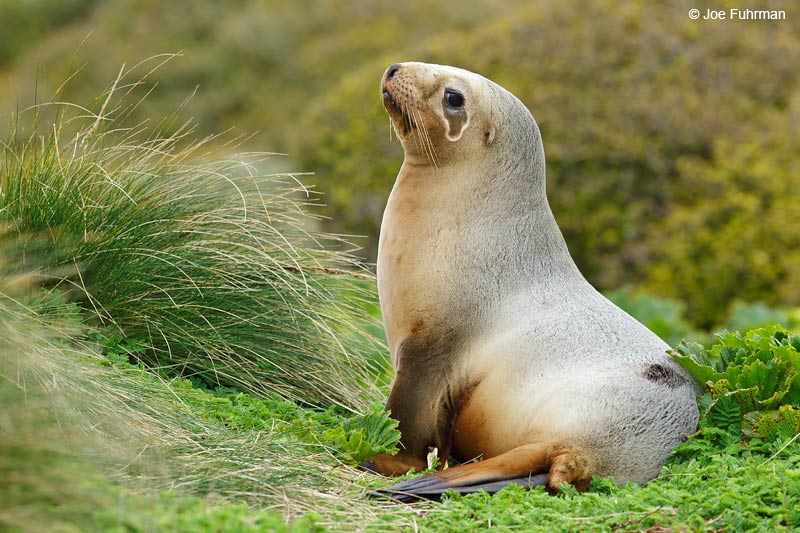
When you think of New Zealand’s unique wildlife, the kiwi bird or the majestic albatross might first come to mind. But offshore, in the wild and often remote waters of the subantarctic, lives one of the rarest and most endearing sea lion species in the world: the Hooker’s Sea Lion, more commonly and appropriately known today as the New Zealand Sea Lion (Phocarctos hookeri).
This fascinating pinniped is endemic to New Zealand, meaning it’s found nowhere else on Earth. Its journey from near extinction to a hopeful, yet still fragile, recovery is a compelling story of resilience and dedicated conservation.
A Striking Appearance and Curious Nature
New Zealand Sea Lions are quite distinct in appearance. Males are significantly larger than females, boasting a dark brown to black coat, often with a shaggy mane around their neck and shoulders, and a powerful, almost blunt snout. They can reach lengths of up to 10 feet and weigh over 880 pounds. Females are noticeably smaller and much lighter in color, typically cream or yellowish-fawn with darker flippers and heads, reaching about 6.5 feet long and weighing around 220 pounds. Pups are born a beautiful dark chocolate brown, almost black.
These sea lions are known for their inquisitive and often playful nature. They are less wary of humans than some other sea lion species, especially in areas where they haven’t been historically hunted or disturbed.
Remote Island Strongholds and Mainland Recolonization
Historically, New Zealand Sea Lions were found all around the main islands of New Zealand. However, extensive hunting in the 19th century decimated their populations, driving them to near extinction. Their primary strongholds today are the remote, windswept Auckland Islands and Campbell Island, both part of New Zealand’s subantarctic islands. These islands offer pristine, predator-free breeding grounds.
Encouragingly, in recent decades, small but growing populations have started to re-establish on the mainland of New Zealand, particularly on the Otago Peninsula near Dunedin on the South Island, and occasionally further north. This recolonization is a vital step in their recovery.
Deep Divers of the Continental Shelf
New Zealand Sea Lions are impressive divers, spending a significant amount of time foraging on the continental shelf and slope. They can dive to depths of over 2,000 feet (more than 600 meters) and hold their breath for up to 10 minutes, hunting a diverse diet of octopus, squid, various fish, and even penguins. Their exceptional diving abilities are crucial for accessing their preferred prey.
The Path to Recovery: A Fragile Future
Despite their recent re-establishment on the mainland, the New Zealand Sea Lion remains Nationally Vulnerable (New Zealand threat classification system) and is listed as Endangered by the IUCN. Their population is still very small, estimated at around 12,000 individuals, and faces unique challenges:
- Fisheries Bycatch: Accidental entanglement and drowning in trawl fishing nets (particularly the squid fishery off the Auckland Islands) have been, and remain, the most significant threat. Mitigation measures, such as sea lion exclusion devices (SLEDs) and fishing closures, are being implemented, but the issue requires ongoing management.
- Disease Outbreaks: Historical disease outbreaks, particularly bacterial infections, have caused significant pup mortality at the main breeding colonies.
- Habitat Disturbance: As they recolonize the mainland, interaction with humans, dogs, and vehicles becomes a concern, requiring careful management of shared coastal spaces.
- Prey Availability: Changes in ocean productivity or overfishing could impact their food sources.
A Conservation Success in the Making
The return of the New Zealand Sea Lion to the mainland is a remarkable conservation success story, illustrating the resilience of nature when given a chance. Dedicated research, monitoring, and collaborative efforts between government agencies, scientists, local communities, and the fishing industry are vital for their continued recovery.
To see a New Zealand Sea Lion in the wild is a privilege. If you are lucky enough to encounter one, particularly on the Otago Peninsula, observe them from a respectful distance and appreciate these unique and determined survivors of the southern seas. Their future relies on our continued understanding and protection.
Keep exploring:
- A Deep Dive into the Wonderful World of Sea Lions
- Sea Lions vs Seals: Unraveling the Mystery of Pinnipeds
More photos below ↓




Disclaimer: This blog post is for edutainment purposes only and may not be entirely accurate.






